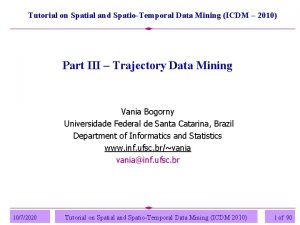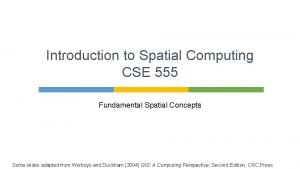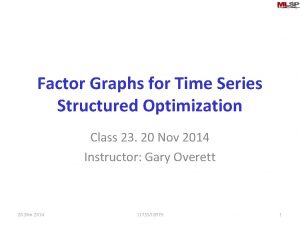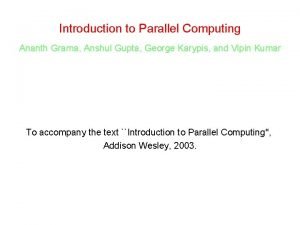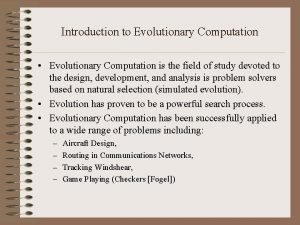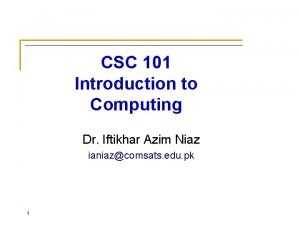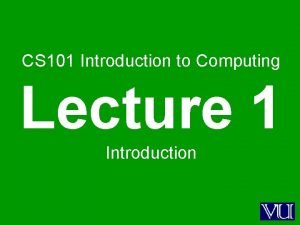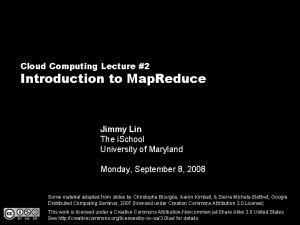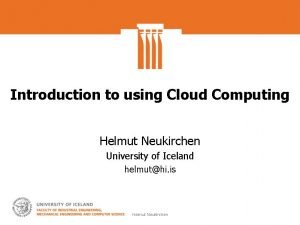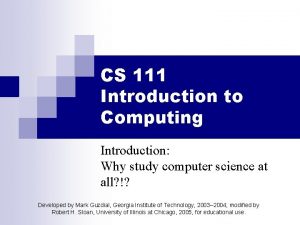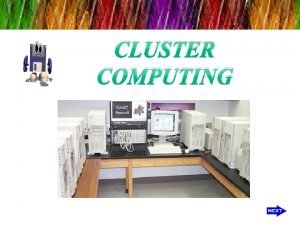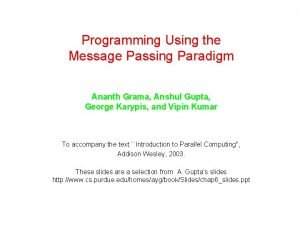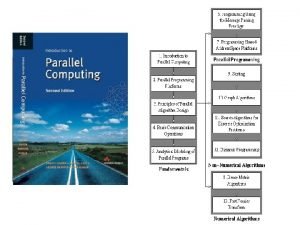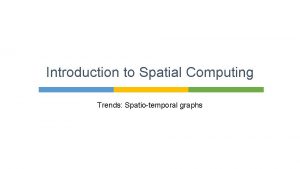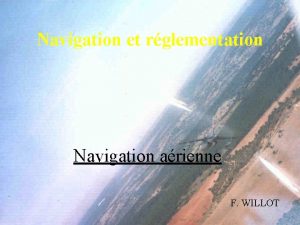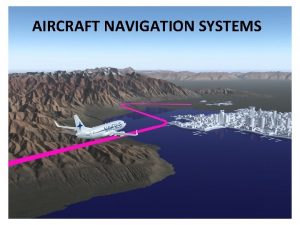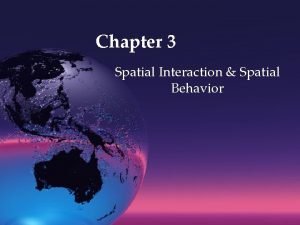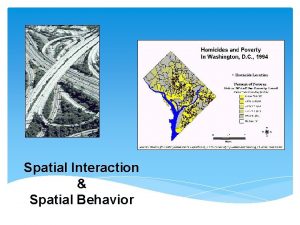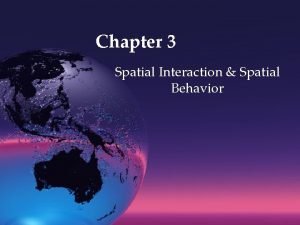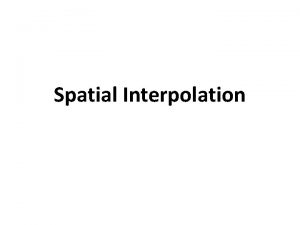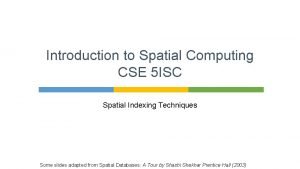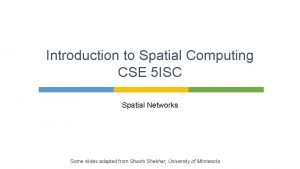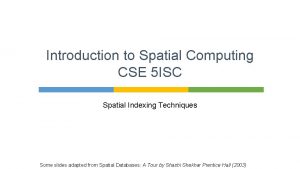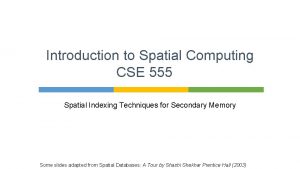Introduction to Spatial Computing Trends Spatiotemporal graphs Navigation












![Modelling Traveler’s Frame of Reference: Time Aggregated Graphs [2 2 2 1] B D Modelling Traveler’s Frame of Reference: Time Aggregated Graphs [2 2 2 1] B D](https://slidetodoc.com/presentation_image_h2/69a6ecd960bfcf1158b8b19e9af9bbab/image-13.jpg)
















- Slides: 29

Introduction to Spatial Computing Trends: Spatio-temporal graphs

Navigation Systems • Historical § Navigation is a core human activity for ages! § Trade-routes, Routes for Armed-Forces • Recent Consumer Platforms § Devices: Phone Apps, In-vehicle, “GPS”, … § WWW: Google Maps, Map. Quest, … • Services • • • Display map around current location Compute the shortest route to a destination Help drivers follow selected route

Background: Traditional Roadmaps Dinky town Roadmap Corresponding Digital Representation 5 th Ave SE edge Intersection between 5 th Ave SE and 5 th St Intersection between 5 th Ave Network only SE and 4 th St US Road few Gigabytes Source: Google Maps Attributes of 5 th Ave SE road segment between N 4 and N 7 N 4

Upcoming Temporally Detailed (TD) Roadmaps Source: ESRI and NAVTEQ

TD ROADMAP BASED ROUTING SERVICES Traditional routing query § “Find shortest path between UMN and Airport” Additional features enabled by TD roadmaps § At what departure time? § Non-rush hour choice ≠ Rush hour choice § Preference metric?

COMPARE TD ROADMAP WITH TRADITIONAL ROADMAP § Pilot study done by Microsoft in Beijing using 30, 000 taxis § How much travel time can be saved using TD roadmaps ? § We can save on avg 20% in travel time by considering the dynamic congestion patterns. Best paper runner up Jing Yuan, Yu Zheng, Chengyang Zhang, Wenlei Xie, Xing Xie, and Yan Huang, T-Drive: Driving Directions Based on Taxi Trajectories, in ACM SIGSPATIAL GIS 2010,

Challenges of TD Roadmap based Routing Services § Challenge 1: Candidate routes should be evaluated from the perspective of a traveler Compare routes for 5: 00 pm departure • I-35 W • Hiawatha Route Digital Road Map Legend: A-I-D: UMN-I 35 W-Airport A-H-D: UMN-Hiawatha-Airport Path Cost from Traveler Pers. Cost at 5: 00 pm Snapshot A-I-D 27 mins 20 mins A-H-D 25 mins

Challenges of TD Roadmap based Routing Services § Candidate routes should be evaluated from the perspective of a travelers Compare routes for 5: 00 pm departure • I-35 W • Hiawatha Route Digital Road Map Legend: A-I-D: UMN-I 35 W-Airport A-H-D: UMN-Hiawatha-Airport Path Cost from Traveler Pers. 5: 00 PM Snapshot A-I-D 27 mins 20 mins A-H-D 25 mins

Challenges of TD Roadmap based Routing Services § Candidate routes should be evaluated from the perspective of a travelers Compare routes for 5: 00 pm departure • I-35 W • Hiawatha Route Digital Road Map Legend: A-I-D: UMN-I 35 W-Airport A-H-D: UMN-Hiawatha-Airport Path Cost from Traveler Pers. 5: 00 PM Snapshot A-I-D 27 mins 20 mins A-H-D 25 mins

Challenges of TD Roadmap based Routing Services § Candidate routes should be evaluated from the perspective of a travelers Compare routes for 5: 00 pm departure • I-35 W • Hiawatha Route Digital Road Map Legend: A-I-D: UMN-I 35 W-Airport A-H-D: UMN-Hiawatha-Airport Path Cost from Traveler Pers. 5: 00 PM Snapshot A-I-D 27 mins 20 mins A-H-D 25 mins

Challenges of TD Roadmap based Routing Services § Candidate routes should be evaluated from the perspective of a travelers Compare routes for 5: 00 pm departure • I-35 W • Hiawatha Route Digital Road Map Legend: A-I-D: UMN-I 35 W-Airport A-H-D: UMN-Hiawatha-Airport Path Cost from Traveler Pers. 5: 00 PM Snapshot A-I-D 27 mins 20 mins A-H-D 25 mins

Modelling Traveler’s Frame of Reference: Time Expanded Graphs
![Modelling Travelers Frame of Reference Time Aggregated Graphs 2 2 2 1 B D Modelling Traveler’s Frame of Reference: Time Aggregated Graphs [2 2 2 1] B D](https://slidetodoc.com/presentation_image_h2/69a6ecd960bfcf1158b8b19e9af9bbab/image-13.jpg)
Modelling Traveler’s Frame of Reference: Time Aggregated Graphs [2 2 2 1] B D A [1 1 2 1] [1 1 2 2] C [3 1 1 1]

Modelling Traveler’s Frame of Reference: Time Aggregated Graphs T = 0 1 2 3 …. ++++ [2 2 2 1] B D A [1 1 2 1] [1 1 2 2] C [3 1 1 1] [2 3 4 4] B D A Arrival Time Transformation [1 2 4 4] [1 2 4 5] C [3 2 3 4]

Sample Query: All start-time Lagrangian Shortest Path (ALSP) Problem

All start-time Lagrangian Shortest Path (ALSP) Problem Instance Ø Query Input: Ø Temporally Detailed Roadmap Ø Source: UMN (Point A) Ø Destination: MSP Airport (Point B) Ø Departure-time: 7: 30 am -- 9: 15 am Ø Desired Output: Ø I-35 W (7: 30 am--8: 30 am) Ø Hiawatha Ave (8: 45 am--9: 15 am) Ø Or a best departure-time and its corresponding route Source: Bing Maps Time Preferred Route 7: 30 am Via I-35 W 7: 45 am Via I-35 W 8: 00 am Via I-35 W 8: 15 am Via I-35 W 8: 30 am Via I-35 W 8: 45 am Via Hiawatha Ave 9: 00 am Via Hiawatha Ave 9: 15 am Via Hiawatha Ave

Challenges of a Naïve Approach Source: Bing Maps § Naïve Approach Re-compute shortest paths for all times Performs redundant work, e. g. between 7: 30– 8: 30 am § How can we reduce the redundant work? § Can we skip some departure-times? Ø Can we Close nodes for multiple departure-times? Invalidates the assumptions of Dynamic Programming!

Concept of Critical-time-point based Approaches Critical-Time-Point Source: Bing Maps Critical-time-point: Departure-times at which the ranking among candidate routes change e. g. 7: 30 am (trivially) and 8: 45 am. ØObservation: Between any two critical-time-points ranking is stationary, i. e. , dynamic programming is applicable.

How to Compute Critical-time-points? (1/2) Basic Computation Unit (one ALSP Iteration): v Compute a shortest path for one departure-time v Forecast a lower bound on next critical-time-point Implementation Sketch: Compute successive “Basic Computation Units” until the next lower bound forecasted is out of input departure-time interval

How to Compute Critical-time-points? (2/2) Basic Framework of a Critical-time-point Approach: Step 1: Model the cost of candidates. Ø Each candidate path is associated with a cost-function. Ø This cost function is put in the temporally-detailed priority queue. Step 2: Enumerate candidates. Ø Use a expand refine strategy (similar to Dijkstra’s)

Temporally-Detailed Priority Queues Traditional Priority Queues 3 4 1112 30 18 8 Temporally-Detailed Priority Queues 12 17 10 14 20 9 4 5 6 7 8 9 1516 6 Ordering: Increasing or decreasing of scalar values 6 8 9 10 12 17 …. 3 4 1112 4 5 6 7 8 9 1516

Temporally-Detailed Priority Queues Traditional Priority Queues 8 9 10 12 17 …. 3 4 1112 6 4 5 6 7 8 9 1516

Forecast-End-of-Dominance-Time-Interval() Operation Ø Called before Extract-Dominant-TS() (or Extract. DTS()) Operation Ø Returns 1+maximum time for the current Extract-Min holds its validity Forecast-End-of-Dominance-Time-Interval operation(t_pr) (Forecast. EDT() for short) T= 0 1 2 3 3 4 1112 4 5 6 7 8 9 1516 Returns t=2 Key Properties: Extract. DTS() operation 3 4 1112 4 5 6 7 8 9 1516

Step 1: Modeling Cost of Paths and Computing Critical-time-points Journey departing from C at t=0, 1, 2. . Would reach D at t=3, 4, 5. . Path functions represent the arrival time at the end-node of path as function of departuretime at the start-node

Step 2: Enumerating Candidate paths (1/2) Source: S Destination: D Lambda = {0 , 1, 2, 3} Put Partial paths in a TDPQ with t_pr = 0 (1) Extract-Min (2) Forecast. EDT() returns 2 (B closed) (3) Insert(S-B-C) and Insert(S-B-D) Proposition A: We have shortest path from S to B for times t=0, 1 (1) Extract. Min (2) Forecast. EDT() returns 2 (C closed) (3) Insert(S-B-C) and Insert(S-B-C-D) Proposition A: We have shortest path from S to C for times t=0, 1

Enumerating Candidate paths (2/2) Source: S Destination: D Lambda = {0 , 1, 2, 3} Ø Continue until destination is not expanded. Ø Maintain min of Forecast. EDT()s Using Proposition A we know the path to Destination is optimal for times between current-time and min of “Forecast. EDT()s” Restart exploration for time = min{Forecast. EDT()}

Challenge of Non-FIFO behavior Waiting can leading to quicker paths!!! *Flight schedule between Minneapolis and Austin (TX) Ø Violates the no wait assumption of Dijkstra/A*

Handling Non-FIFO Behavior (Earliest Arrival Time Series Transformation) Observation: ØEarliest arrival time series is FIFO in nature.

Time aggregated Graph with Earliest arrival time series Observation: ØEarliest arrival time series is FIFO in nature.
 Spatiotemporal data mining
Spatiotemporal data mining Spatial data vs non spatial data
Spatial data vs non spatial data Describing trends
Describing trends Upward trend graph
Upward trend graph Spatial computing
Spatial computing State graphs in software testing
State graphs in software testing Speed and velocity
Speed and velocity Graphs that enlighten and graphs that deceive
Graphs that enlighten and graphs that deceive 5-3 practice polynomial functions
5-3 practice polynomial functions Conventional computing and intelligent computing
Conventional computing and intelligent computing Factor graphs and gtsam: a hands-on introduction
Factor graphs and gtsam: a hands-on introduction Regarder introduction to cloud computing
Regarder introduction to cloud computing Introduction to parallel computing ananth grama
Introduction to parallel computing ananth grama Introduction to evolutionary computing
Introduction to evolutionary computing It 101 - introduction to computing
It 101 - introduction to computing It 101 introduction to computing
It 101 introduction to computing Introduction to mapreduce in cloud computing
Introduction to mapreduce in cloud computing Introduction to ubiquitous computing
Introduction to ubiquitous computing Introduction to mobile computing
Introduction to mobile computing It 101 introduction to computing
It 101 introduction to computing Distributed systems overview
Distributed systems overview Introduction to cloud computing
Introduction to cloud computing Grid computing introduction
Grid computing introduction Overview of grid computing
Overview of grid computing Introduction to cloud computing
Introduction to cloud computing It 111 introduction to computing
It 111 introduction to computing Conclusion of cluster computing
Conclusion of cluster computing Practitioner myths in software engineering
Practitioner myths in software engineering Introduction to parallel computing ananth grama ppt
Introduction to parallel computing ananth grama ppt Introduction to parallel computing ananth grama
Introduction to parallel computing ananth grama
